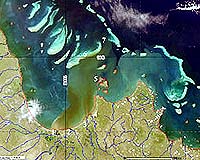| . |  |
. |
Portland OR (SPX) Jan 07, 2010 A study recently completed in the gulf coast of Alaska by federal and university researchers has found that as glacial ice disappears, the production and export of high- quality food from glacial watersheds to marine ecosystems may disappear too. This trend could have serious consequences for marine food webs. The study, "Glaciers as a source of ancient and labile organic matter to the marine environment," was recently published in the December 24, 2009, issue of the journal Nature. The research, which was conducted on 11 coastal watersheds in the Gulf of Alaska, has documented an interesting paradox with important implications for coastal ecosystems. "Glacial watersheds comprise 30 percent of the Tongass National Forest and supply about 35 to 40 percent of the stream discharge," says Rick Edwards, a coauthor on the study. "These watersheds export dissolved organic matter that is remarkably biologically active in contrast to that found in other rivers. Generally, scientists expect that organic matter decreases in its quality as a food source as it ages, becoming less and less active over time." But the dissolved organic material discharged from the glacial watersheds in this study was almost 4,000 years old; yet surprisingly, more than 66 percent of it was rapidly metabolized by marine microbes into living biomass to support marine food webs, adds Edwards. The study was conducted by Eran Hood, University of Alaska Southeast; Jason Fellman, University of Alaska Fairbanks; Robert Spencer and Peter Hernes, University of California Davis; Rick Edwards and David D'Amore, Pacific Northwest (PNW) Research Station, USDA Forest Service; and Durelle Scott, Virginia Tech. Edwards and D'Amore partnered with their university colleagues to characterize the dominant types of watersheds and variables that control the volume and chemistry of water flowing into the gulf. The study was led by Hood and Fellman, then a graduate student working in the PNW Research Station's Juneau Forestry Sciences Lab. Rivers fringing the gulf coast of Alaska discharge as much water as the Mississippi River into a marine system that harbors the most productive salmon fishery in the world. As these rivers flow through the temperate rain forests on the coastal margin, they are influenced by vegetation, soils and wetlands, which control the amount and timing of carbon and nutrients delivered to the productive coastal ecosystems receiving that drainage. "Understanding how these various watersheds respond to management activities and climate change is essential in mitigating the impacts of a warming climate on habitat quality within rivers and productivity within the adjacent marine ecosystem," explains Edwards. "We don't currently have much information about how runoff from glaciers may be contributing to productivity in downstream marine ecosystems," said Hood. "This is a particularly critical question given the rate at which glaciers along the Gulf of Alaska are thinning and receding."
Highlights of the study include: + The greater the amount of glacier in the watershed, the older the dissolved organic matter and the more available it is to marine organisms. + These results support the hypotheses that microbial communities beneath the glaciers grow on soils and forests overrun by the glaciers during the Hypsithermal warm period (between 7,000-2,500 years ago). As they degrade the ancient material, they make new food from old carbon. + The quality of the dissolved organic matter is so high that 23 to 66 percent is used by marine micro-organisms and incorporated into food webs supporting higher organisms. + As glaciers recede and disappear, the input of this valuable food source will decrease with unknown impacts on productivity of marine food webs. To read the entire article in Nature.
Share This Article With Planet Earth
Related Links USDA Forest Service, Pacific Northwest Research Station Water News - Science, Technology and Politics
 Seaweed chokes Australia's Great Barrier Reef
Seaweed chokes Australia's Great Barrier ReefSydney (AFP) Jan 6, 2010 Australian natural wonder the Great Barrier Reef is overgrown in places by seaweed in what could be a worrying indication of the health of the coral structure, scientists said on Wednesday. Surveys of the World Heritage-listed reef, already at risk from global warming, found that more than 40 percent of areas closest to shore were dominated by green weed, Professor David Bellwood said. ... read more |
|
| The content herein, unless otherwise known to be public domain, are Copyright 1995-2009 - SpaceDaily. AFP and UPI Wire Stories are copyright Agence France-Presse and United Press International. ESA Portal Reports are copyright European Space Agency. All NASA sourced material is public domain. Additional copyrights may apply in whole or part to other bona fide parties. Advertising does not imply endorsement,agreement or approval of any opinions, statements or information provided by SpaceDaily on any Web page published or hosted by SpaceDaily. Privacy Statement |